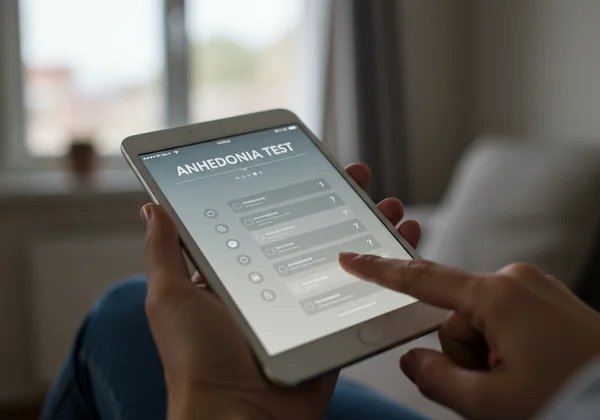Anhedonia Test & Coping: Strategies for Rediscovering Joy
Feeling a persistent lack of interest or joy in activities you once loved can be a disorienting and isolating experience. If the world seems to have lost its color and you feel emotionally numb, you're not alone. This feeling has a name: anhedonia. But a name is just a starting point. The real question is, what comes next? How do you test for anhedonia and begin the journey back to pleasure and engagement?
This article delves into understanding anhedonia, offering actionable, non-pharmacological strategies to help you navigate this challenging state and rediscover joy. Understanding your experience is the first step toward rediscovering your capacity for joy. For a confidential and insightful starting point, you can always begin by understanding your feelings with a structured assessment.

Understanding How to Address Anhedonia
Before you can build strategies, you need a solid foundation of understanding. Addressing anhedonia begins with recognizing how it uniquely affects you and acknowledging that self-assessment is a powerful tool for insight. This awareness is not about self-diagnosis but about empowering yourself with knowledge to take meaningful next steps.
Identifying Your Experience of Lost Pleasure
Anhedonia isn’t a one-size-fits-all experience. It can manifest in different areas of your life. Social anhedonia, for example, is characterized by a reduced interest in social contact and a diminished ability to feel pleasure from interpersonal situations. You might find yourself avoiding friends or feeling nothing during conversations that used to excite you.
Physical anhedonia relates to the inability to feel pleasure from bodily sensations, like the taste of your favorite food, the warmth of a hug, or the beauty of a sunset. The common thread is a muted emotional response. Recognizing which aspects of your life are most affected by these anhedonia symptoms is a crucial part of the process.
The First Step: Self-Assessment & Insight
Once you begin to identify these patterns, the next logical step is to gain clearer insight. How significant is this loss of pleasure? A structured self-assessment can provide a valuable baseline. This is where an online anhedonia test can be incredibly helpful. It moves beyond vague feelings and uses scientifically validated questions to help quantify your experience.
Taking a confidential and anonymous anhedonia quiz gives you a private space to reflect honestly on your feelings without pressure. The results can serve as a personal benchmark, helping you understand the current state of your emotional well-being and providing a concrete starting point for discussion, whether with yourself, a loved one, or a professional. If you're ready to gain clarity, you can take our anhedonia test now.

Practical Strategies for Coping with Anhedonia Daily
Living with anhedonia can feel like being stuck in neutral. The key to moving forward is to gently re-engage with life, even when the motivation isn't there. The following strategies are practical, evidence-based techniques you can integrate into your daily routine to slowly rekindle your connection to pleasure and purpose.
Embracing Behavioral Activation: Rekindling Engagement
Behavioral activation is one of the most effective strategies for combating anhedonia. This therapeutic approach focuses on a simple yet powerful principle: action can precede motivation. By gently re-engaging with activities, even when motivation is low, you can begin to rekindle a sense of pleasure and purpose.
Start small to avoid feeling overwhelmed.
- Schedule one pleasant activity per day: This could be listening to a single song without distractions, spending five minutes in the sun, or sketching in a notebook.
- Focus on the action, not the feeling: The goal is to simply complete the task. Don't put pressure on yourself to feel immediate joy. The rewiring of your brain's reward circuits is a gradual process.
- Track your progress: Note down what you did. Over time, you may begin to notice subtle shifts in your mood or energy levels, reinforcing the effort.

Cultivating Mindfulness and Presence for Emotional Awareness
Since anhedonia often involves a sense of disconnection from your own emotions and sensations, practicing mindfulness can help bridge that gap. Mindfulness is the art of paying attention to the present moment without judgment. It helps you tune back into your senses.
You can practice mindfulness anywhere.
- Mindful Breathing: Take a few minutes to focus solely on the sensation of your breath entering and leaving your body.
- The Five Senses Exercise: Pause and identify five things you can see, four things you can feel, three things you can hear, two things you can smell, and one thing you can taste. This grounds you in the present.
- Mindful Eating: When you eat, pay full attention to the flavors, textures, and smells of your food. This can help reconnect you with physical pleasure.
Nurturing Your Body: The Foundation of Mental Well-being
Your physical health is inextricably linked to your mental state, making consistent, supportive habits a priority. This isn't about drastic overhauls. Instead, focus on the three critical pillars for improving mood and energy: physical activity, nutrition, and sleep.
Gentle, consistent exercise can increase the production of endorphins and dopamine, neurochemicals related to pleasure and reward. A balanced diet rich in nutrients supports healthy brain function. Finally, establishing a regular sleep schedule can have a profound impact on your emotional resilience. These physical health practices create a stable foundation from which emotional healing can grow.
Reconnecting: Addressing Social Anhedonia Challenges
For those experiencing social anhedonia, the prospect of interacting with others can feel exhausting. The desire to withdraw is strong, but isolation can deepen the feelings of numbness. Gently and strategically re-engaging is essential for recovery.
Taking Small Steps Towards Social Re-engagement
The key is to start with low-stakes interactions that don't feel overwhelming. This approach respects your current capacity while still gently pushing the boundary of your comfort zone. The goal is not to become the life of the party overnight but to slowly rebuild social stamina.
Consider trying one of these:
- Send a text to a friend simply to say hello.
- Have a short, five-minute phone call.
- Plan a brief, structured outing, like a 15-minute coffee with a trusted individual.
Nurturing Meaningful Connections
As you re-engage, focusing on quality over quantity is crucial. Spending time with supportive, empathetic people is more beneficial than forcing yourself into large, draining social events. Spend time with individuals who you feel safe with and who understand that you may not be your usual self. True connection can be a powerful antidote to emotional numbness.
When to Consider Professional Help for Anhedonia
While self-help strategies are powerful, it's also important to recognize when you might need more support. If anhedonia persists and significantly impacts your ability to function, it may be time to consider professional help. This is a sign of strength and self-awareness.
Types of Therapy for Anhedonia: What to Expect
Several types of therapy have proven effective for anhedonia. Cognitive Behavioral Therapy (CBT), for instance, can help you identify and challenge the thought patterns that contribute to your experience. A therapist can work with you to implement behavioral activation and other tailored strategies in a structured, supportive environment.
Finding the Right Mental Health Professional for You
Finding the right mental health professional is a personal journey. You can start by asking your primary care doctor for a referral or looking through online directories. Bringing the results of an online anhedonia test to your first appointment can provide a valuable, objective starting point for the conversation, helping the professional understand your experience more quickly.

Your Journey to Rediscovering Joy Starts Now
Coping with anhedonia is a journey of small, intentional steps. It requires patience, self-compassion, and the right tools. By understanding your experience, implementing practical strategies like behavioral activation and mindfulness, and knowing when to seek professional support, you can begin to navigate your way out of the fog.
The first step is always awareness. Gaining insight into your emotional state is the foundation upon which all other progress is built. If you're ready to take that crucial first step, we invite you to take the free anhedonia test on our homepage. It's confidential, science-based, and designed to give you the clarity you need to start your journey toward rediscovering joy.
Common Questions About Anhedonia & Rediscovering Pleasure
How do you test for anhedonia?
Anhedonia is formally assessed by mental health professionals using clinical interviews and validated questionnaires, such as the Snaith-Hamilton Pleasure Scale (SHAPS). For self-assessment, individuals can use online screening tools. Our website offers a free, confidential SHAPS test that provides immediate insights into your capacity for pleasure based on these established scientific principles.
Does anhedonia ever go away?
Yes, for many people, anhedonia can be improved and even resolved. Recovery is a gradual process that often involves a combination of strategies, including therapy, lifestyle adjustments, and sometimes medication under a doctor's guidance. The key is consistent effort and finding the right support system.
What worsens anhedonia?
Several factors can worsen anhedonia. These include chronic stress, social isolation, poor sleep, a sedentary lifestyle, and substance use. Ignoring the symptoms and withdrawing further from activities and social connections can create a cycle that deepens the feeling of emotional numbness.
Can people with anhedonia cry?
Yes, they can. Anhedonia is specifically about the loss of pleasure or interest, not necessarily the absence of all emotions. Someone with anhedonia might still experience sadness, frustration, or anger and be able to cry. However, others may experience a more pervasive emotional flatness where even strong negative emotions feel muted.